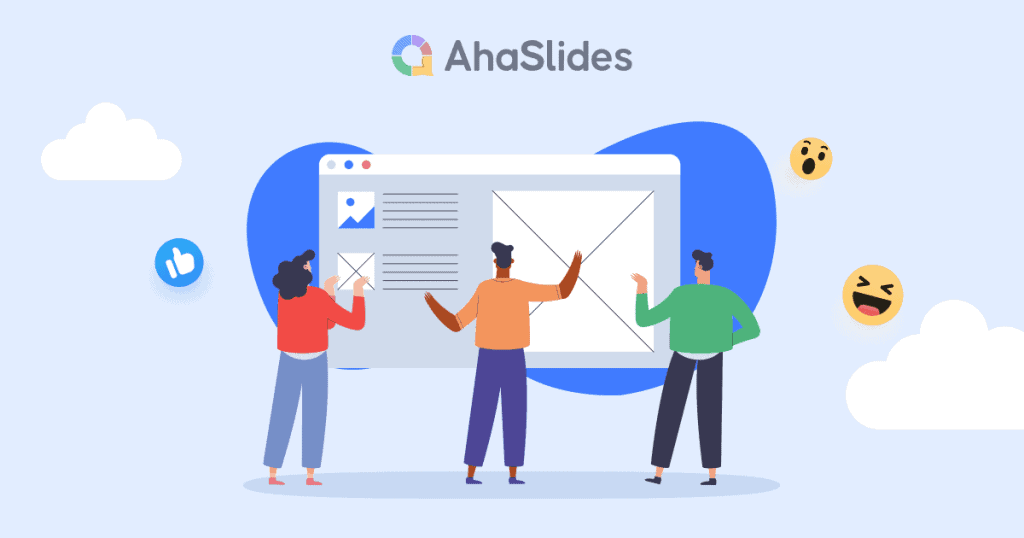Put a finger down if you have…
- …done a presentation in your life.
- …struggled with summarising your content 🤟
- …rushed while preparing and ended up throwing every single bit of text you have on your poor little slides 🤘
- …made a PowerPoint presentation with loads of text slides ☝️
- …ignored a display crammed with text and let the presenter’s words go in one ear and out the other ✊
So, we all share the same problem with text slides: not knowing what’s right or how much is enough (and even getting fed up with them sometimes).
But it’s no longer a big deal, as you can look at the 5/5/5 rule for PowerPoint to know how to create a non-bulky and effective presentation.
Find out everything about this type of presentation, including its benefits, drawbacks and examples in the article below.
Table of Contents
- Overview
- What is the 5/5/5 rule for PowerPoint?
- Benefits of the 5/5/5 rule
- Cons of the 5/5/5 rule
- Summary
- Frequently Asked Questions
More Presentation Tips with AhaSlides

Start in seconds.
Get free templates for your next interactive presentation. Sign up for free and take what you want from the template library!
🚀 Grab Free Account
What Is the 5/5/5 Rule for PowerPoint?
The 5/5/5 rule sets a limit on the amount of text and the number of slides in a presentation. With this, you can keep your audience from being overwhelmed with walls of text, which can lead to boredom and searching elsewhere for distractions.
The 5/5/5 rule suggests you use a maximum of:
- Five words per line.
- Five lines of text per slide.
- Five slides with text like this in a row.

Your slides shouldn’t include everything you say; it’s a waste of time to read out loud what you’ve written (as your presentation should only last under 20 minutes) and it’s incredibly dull for those in front of you. The audience is here to listen to you and your inspiring presentation, not to see a screen that looks like another heavy textbook.
The 5/5/5 rule does set boundaries for your slideshows, but these are to help you keep your crowd’s attention better.
Let’s break down the rule 👇
Five words on a line
A good presentation should include a mix of elements: written & verbal language, visuals, and storytelling. So when you make one, it’s best not to centre around the texts only and forget everything else.
Cramming too much information on your slide decks doesn’t help you at all as a presenter, and it’s never on the list of great presentation tips. Instead, it gives you a lengthy presentation and disinterested listeners.
That’s why you should only write a few things on each slide to trigger their curiosity. According to 5 by 5 rules, it’s no more than 5 words on a line.
We understand that you have a bunch of beautiful things to share, but knowing what to leave out is as important as knowing what to put in. So, here’s a quick guide to help you do this with ease.
🌟 How to do it:
- Use question words (5W1H) - Put a few questions on your slide to give it a touch of mystery. You can then answer everything by speaking.
- Highlight keywords - After outlining, highlight keywords that you want your audience to pay attention to, and then include them on the slides.
🌟 Example:
Take this sentence: “Introducing AhaSlides – an easy-to-use, cloud-based presentation platform that excites and engages your audience through interactivity.”
You can put it in fewer than 5 words in any one of these ways:
- What is AhaSlides?
- Easy-to-use presentation platform.
- Engage your audience through interactivity.
Five lines of text on a slide
Text heavy slide design is not a wise choice for a fascinating presentation. Have you ever heard of the magical number 7 plus/minus 2? This number is the key takeaway from an experiment by George Miller, a cognitive psychologist.
This experiment implies that a human’s short-term memory typically holds 5-9 strings of words or concepts, so it’s hard for most ordinary people to remember more than that in a really short period of time.
That means that 5 lines would be the perfect number for an effective presentation, as the audience can grasp important information and memorise it better.
🌟 How to do it:
- Know what your key ideas are - I know you’ve put tons of thought into your presentation, and everything you’ve included seems so vital, but you need to settle on the main points and summarise them in a few words on the slides.
- Use phrases and sayings - Don’t write the whole sentence, simply pick out the essential words to use. Also, you can add a quote to illustrate your point instead of throwing everything in.
Five slides like this in a row
Having a lot of content slides like this can still be too much for the audience to digest. Imagine 15 of these text-heavy slides in a row - you'd lose your mind!
Keep your text slides to a minimum, and look for ways to make your slide decks more engaging.
The rule suggests that 5 text slides in a row are the absolute maximum you should make (but we suggest a maximum of 1!)
🌟 How to do it:
- Add more visual aids - Use images, videos or illustrations to make your presentations more diverse.
- Use interactive activities - Host games, icebreakers or other interactive activities to connect with your audience.
🌟 Example:
Instead of giving your audience a lecture, try brainstorming together to give them something different that helps them remember your message longer! 👇
Benefits of the 5/5/5 Rule
The 5/5/5 not only shows you how to set a boundary on your word counts and slides, but it can also benefit you in many ways.
Emphasise your message
This rule ensures that you highlight the most critical information to deliver the core message better. It also helps to make you the centre of attention (instead of those wordy slides), which means the audience will be actively listening and understanding your content better.
Keep your presentation from being a ‘read-out-loud’ session
Too many words in your presentation can make you dependent on your slides. You’re more likely to read that text out loud if it’s in the form of long paragraphs, but the 5/5/5 rule encourages you to keep it bite-sized, in as few words as possible.
Alongside that, there are three no-nos you can gain from this:
- No classroom vibe - With 5/5/5, you won’t sound like a student reading everything for the whole class.
- No back to the audience - Your crowd will see your before more than your face if you read the slides behind you. If you face the audience and make eye contact, you’ll be more engaging and more likely to make a good impression.
- No death-by-PowerPoint - The 5-5-5 rule helps you avoid common mistakes while making your slideshow that can make your audience tune out quickly.
Reduce your workload
Preparing tons of slides is exhausting and time-consuming, but when you know how to summarise your content, you don’t have to put too much work into your slides.

Cons of the 5/5/5 Rule
Some people say that rules like this are made up by presentation consultants, as they earn a living by telling you how to make your presentations great again 😅. You can find many similar versions online, like the 6 by 6 rule or 7 by 7 rule, without knowing who invented stuff like this.
With or without the 5/5/5 rule, all presenters should always strive to reduce the amount of text on their slides. 5/5/5 is pretty simple and doesn’t get to the bottom of the problem, which is the way you lay out your content on the slides.
The rule also tells us to include, at most, five bullet points. Sometimes that means filling a slide with 5 ideas, which is way more than the widely held belief that there should be only one idea in a fall. The audience might read everything else and think of the second or third idea while you’re trying to deliver the first one.
On top of that, even if you follow this rule to a tee, you might still have five text slides in a row, followed by an image slide, and then a few other text slides, and repeat. That’s not appealing to your audience; it makes your presentation just as stiff.
The 5/5/5 rule can sometimes go against what is considered good practice in presentations, like having visual communication with your audience or including some charts, data, photos, etc., to illustrate your point clearly.
Frequently Asked Questions
How can you reduce text-heavy slide design?
Be concise at everything like minimizing texts, headings, ideas. Instead of heavy texts, let's show more charts, photos and visualizations, which are easier to absorb.
What is the 6 by 6 rule for Powerpoint presentations?
Only 1 thought per line, no more than 6 bullet points per slide and no more than 6 words per line.








